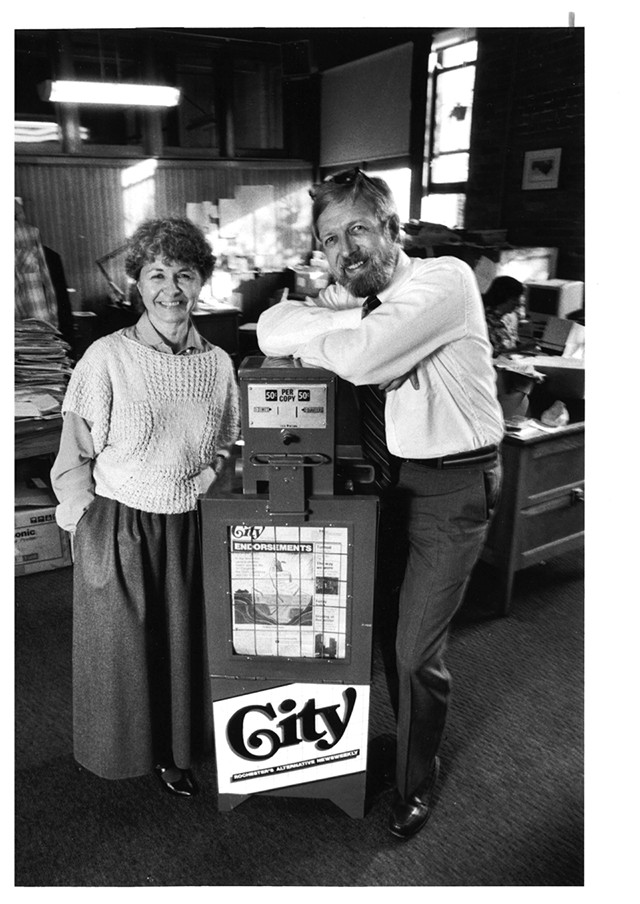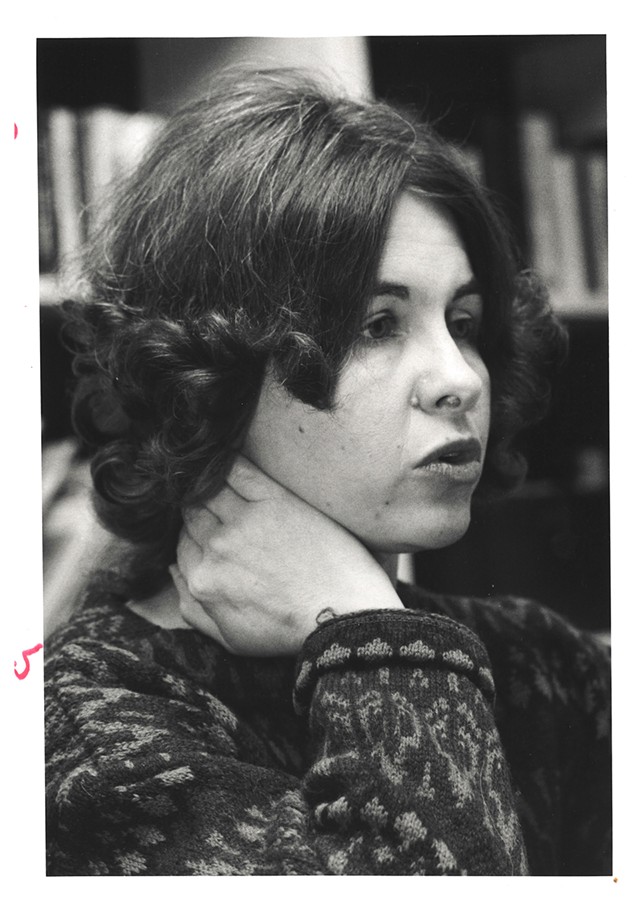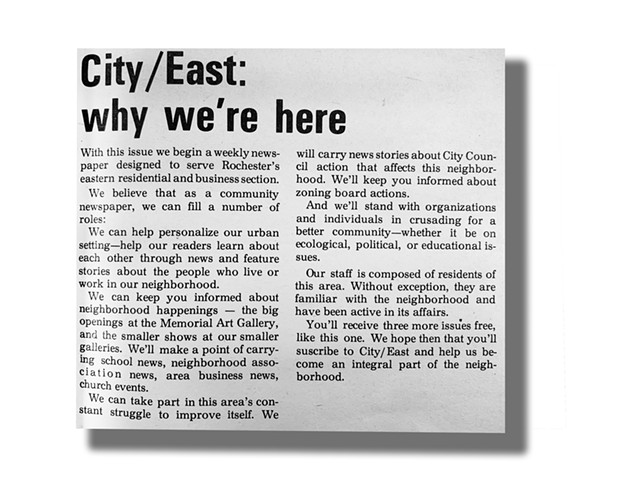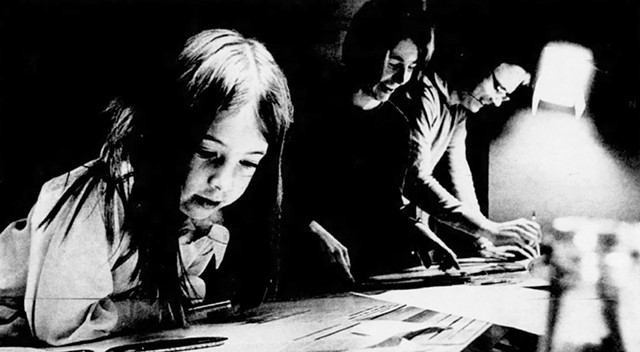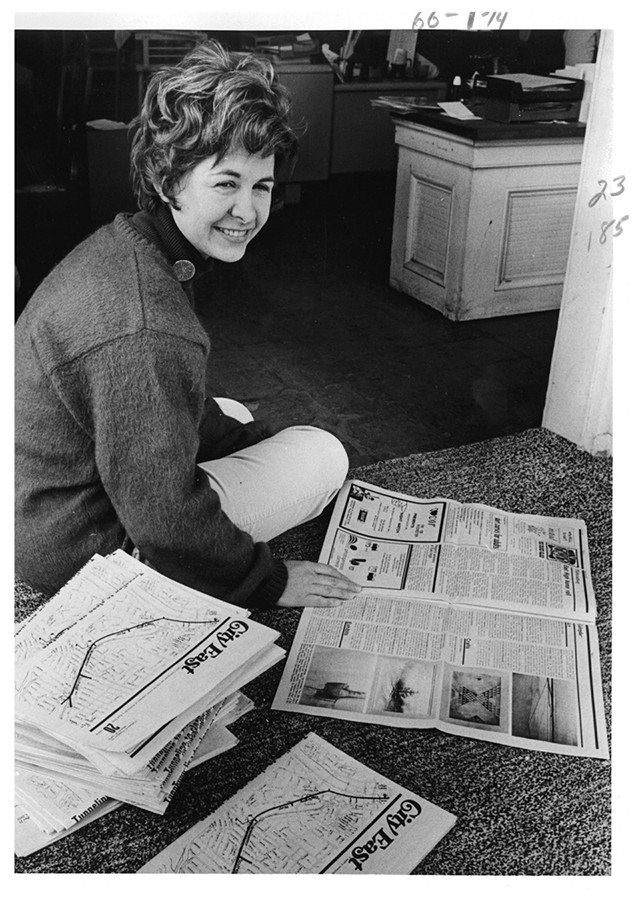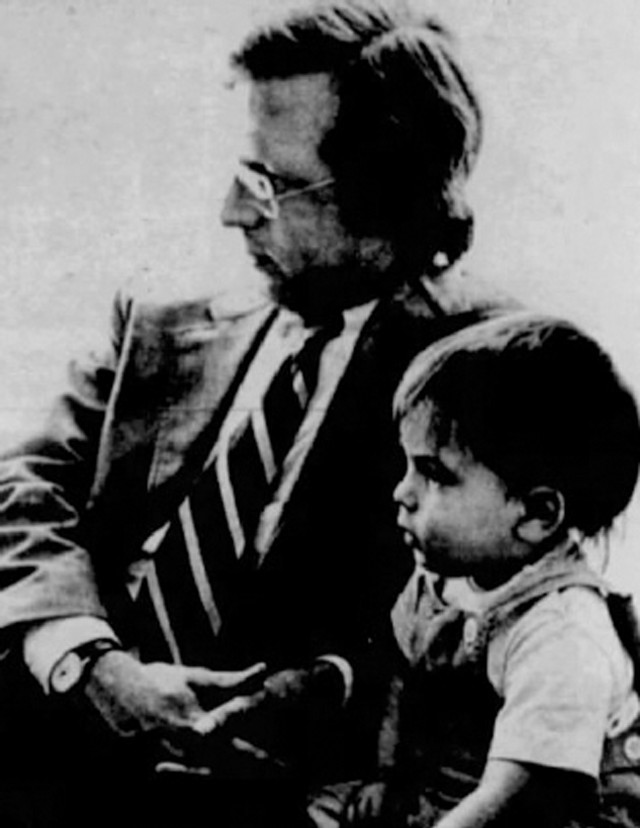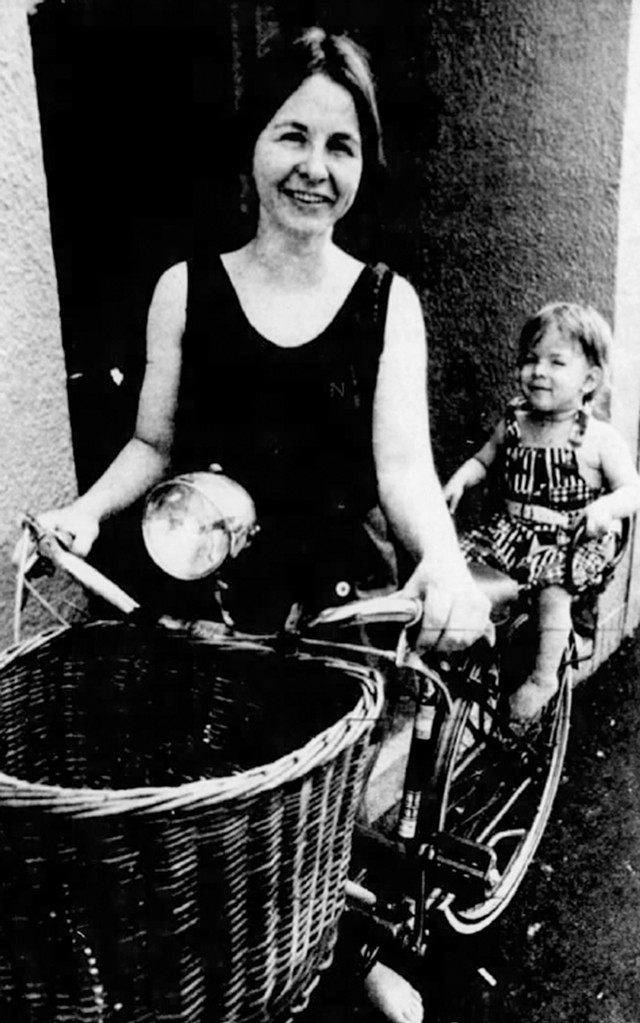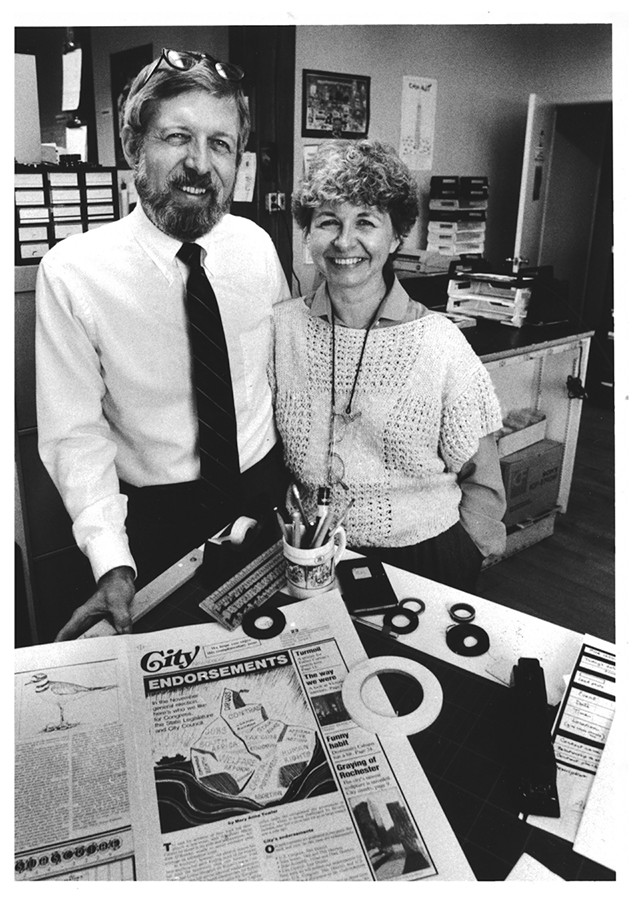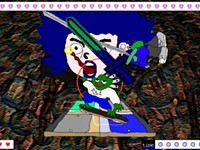[
{
"name": "500x250 Ad",
"insertPoint": "5",
"component": "15667920",
"parentWrapperClass": "",
"requiredCountToDisplay": "1"
}
]
If there was any question as to what Rochester’s newest newspaper was all about, the answer was there in black and white and read all over on the front page of the first edition of CITY/East on Oct. 5, 1971:
We’ll stand with organizations and individuals in crusading for a better community – whether it be on the ecological, political, or educational issues.
This was the coda of what would become CITY, which was launched on a shoestring 50 years ago by husband and wife Bill and Mary Anna Towler amid an explosion of alternative weekly newspapers around the country.
These alt-weeklies, as they were known, would help set the political and cultural agendas of their cities for decades to come by chronicling community controversies and stirring up a few of their own.
That happened to CITY in 1993, when it published a recruitment advertisement for the Ku Klux Klan. An organization of Black ministers picketed CITY and called for a boycott.
“We ran it,” says Mary Anna, who was the editor, “and lots and lots and lots of people were really, really, really offended and really upset.”
She and her husband, the publisher, stood their ground, but published a notice defending freedom of speech that contained an apology to those offended and urged readers to work for racial harmony.
Decades later, and now retired, Mary Anna says she wouldn’t have done anything different.
“At what point do you stop?” she asks. “If you believe in women’s rights or gay rights, or anything else, then do you automatically refuse to take ads from the right-to-life groups? We took a lot of those, and it never entered my mind that I would not take them. Even though I am strongly pro-choice, pro-abortion rights.”
The Towlers slowly walked away from CITY two years ago, when they sold their life’s work to Rochester’s public broadcasting station, WXXI Public Media. But they remain fiercely connected to the city they love.
They moved into The Nathaniel, the trendy new apartment building of shimmering chrome, glass and architectural brick on South Avenue. Their fourth-floor living room looks out onto the Genesee River. From their small balcony, they can hear the roar of water spilling over the Court Street Dam. A telescope was poised at one of the windows, from where they sometimes spot a great blue heron.
All that seems to be missing in their lives is any sign of CITY, which has since transitioned to a monthly glossy magazine with an around-the-clock online presence. Their tidy apartment is the antithesis of the controlled chaos of the newsroom that started in the attic of their Westminster Road home and, when it moved into offices, became their home away from home.
Age has caught up with them. Mary Anna is 84. Bill turns 83 this month. Neurological issues have forced him to glide through their apartment on a scooter, in electric-battery silence. The same neurological problem has reduced his voice to a whisper.
Ostensibly, it was Bill’s job that brought them here. They were Tennessee natives and graduates of the University of Tennessee, where they met and married in 1962.
They lived in Florida for two years, until Bill requested his company, General Dynamics, transfer him to Rochester. That was 1965 and, before long, he’d moved on to Eastman Kodak as a management consultant in industrial engineering.
But in truth, Mary Anna says, they came for the snow.
“The weather in Florida is terrible,” she says. “I do not understand why people think it is so fabulous, but we absolutely hated the weather and missed snow.”
Now they have their wish, by the snow-plow load.
A VOICE FOR THE CITY
When they arrived in Rochester, they wasted no time becoming politically and socially active. They belonged to the Democratic Action Committee, the liberal wing of the Monroe County Democratic Party, and the Civic Music Association.
They helped organize a coffeehouse for teenagers. She co-founded Citizens For Quality Integrated Education. They were on the board for World of Inquiry school. They raised money for the Memorial Art Gallery. They belonged to the Park-Oxford Neighborhood Association, and a zoning coalition.
CITY sprang forth from the Towlers’ dissatisfaction with the coverage of Rochester in the Democrat and Chronicle, and the now-defunct afternoon newspaper, the Times-Union.
“They would cover nice things that were happening in neighborhoods in the suburbs, but they would cover fights and killings in the city,” Mary Anna says. “And particularly fights in city schools, which there were some. And we knew and felt city neighborhoods deserved their own spokesperson, their own way to talk about their own problems.”
CITY/East, the original name of CITY, would become the voice and, in fashion true to the Towlers’ consciousness for their community’s welfare, apologized for killing trees in a note to readers in the inaugural edition:
According to a formula supplied by the Rochester Committee For Scientific Information, it took five trees to supply the newsprint for the 6,000 newspapers we published this week.
We can provide the services of community newspaper — and protect our environment — if readers will save CITY/East and other paper products and turn them into one of the city’s several junk and waste paper firms.
Their tree-fueled newspaper was born in their home amid the family detritus generated by Mary Anna’s self-confessed casual approach to housekeeping, and the chaos of raising three young children. Cheryl was 7, Elizabeth was 5, Will was just 2 when the Towlers launched CITY.
Bill was 33 years old. Mary Anna 34, with some experience working for her hometown Knoxville News-Sentinel. They put up $4,000 of their savings to get started and got another $5,000 from nine civic-minded friends who became stockholders.
They made room in the Westminster Road house for drafting tables needed to lay out the pages. The old third-floor maid’s quarters served as a photo darkroom. Stacks of the newborn newspaper were set on the piano.
The first edition was financed in part by advertisements for political candidates and a Chuck Mangione concert at the Mapledale Party House. Mary Anna clicked away on her manual typewriter, in whatever room she happened to be in: “Would new streetlights spoil the look of the neighborhood?”
GROWING AMBITION
Over the course of its first year, the city view of CITY grew increasingly ambitious. Reporters were sent to City Council, school board, County Legislature and zoning board meetings. An acknowledgment of the arts emerged, with an interview with Rochester Philharmonic Orchestra conductor David Zinman.
By the summer of CITY’s second year, much of the newspaper’s business had moved to a three-room office at 686 Monroe Ave. Easy biking distance for Mary Anna. She and Bill were often working until 2 a.m., checking proofs and pasting up pages. At one point, Mary Anna estimates, she was working 80-hour weeks.
Four years after its birth, CITY/East began showing a profit. Bill was able to quit his job at Kodak.
“We had no plans beyond CITY/East when we first started,” he says. “The group of volunteers that Mary Anna had assembled to put this paper together were all in the neighborhood, right there.
“The growth came because other people saw what we were doing, and wanted it to be for them as well.”
So the Towlers decided to launch CITY/West. That plunged the paper back into the red.
Yet six years in, CITY was up to 40 stockholders. It was surviving on a diet of part-time reporters, photographers, and ad salesmen. The few full-time employees were multi-taskers. The office manager was also a typesetter. A feature writer and layout artist also sold ads.
In 1978, Mary Anna took a gamble on a school teacher named Mark Hare who had grown tired of teaching school. The salary was only $18,000 a year, but then, Hare had no journalism or professional writing experience.
“We were big on reporting everything tiny and local,” Hare says. “So we would go and collect information about every bicycle stolen off of every porch, eggs thrown at somebody’s house and all that kind of stuff, and put it all in the paper.”
By then, CITY had moved to a dining room and living room in the back of an old house on Alexander Street. The front of the house was an architect’s office.
“We were all on top of each other,” Hare says.
Bill would pass along tips for stories as he made his ad-sales rounds. Mary Anna, Hare says, was “ubiquitous.” And an intense, tight editor.
Under Mary Anna’s tutelage, Hare went from reporting on stolen bicycles to major stories. It is not a stretch to suggest that he helped save the George Eastman Museum as it is known today. Mary Anna had heard from a board member that its entire collection of photos, negatives and films was on the verge of being sold. She turned over the story to Hare, who had been on the job for only a few months. He confirmed that the Smithsonian Institution was a likely buyer, and broke the story in CITY.
The Democrat and Chronicle piled on and, Hare says, “After that, everybody was so embarrassed that the whole thing fell apart.”
A few years later, it was three or four months of work before Hare broke the explosive story that the Seneca Army Depot was being used to store nuclear weapons.
CITY campaigned against the University of Rochester’s exploration of moving the Eastman School of Music to its River Campus. Imagine downtown Rochester without it.
And CITY wrote stories critical of a proposal to extend I-390 through the Swillburg section of the city — a plan that Mary Anna says would have destroyed “absolutely wonderful low-, middle-income houses, small affordable housing.”
Houses occupied by poor people. And minorities. Having grown up in segregated Tennessee, the Towlers knew this drill.
“The North did not escape,” Mary Anna says, “and still does not escape, the kind of racial division and hatred that is endemic to the South.”
Hare remembers seeing Mary Anna out as late as 2014, reporting on such issues.
“She was doing all that work herself, even then,” he says.
She had to, especially in the early years. It was not uncommon for CITY reporters to stick around for six months, maybe a year, before moving on. Hare was a long hauler, hanging on for six years, before moving on to the Democrat and Chronicle.
CHANGING WITH THE TIMES
Change was one of the few constants. Even the address. CITY migrated from Alexander Street to 250 North Goodman Street, next to Village Gate Square. CITY/West had a Thurston Road office for a while.
“It was a real mom-and-pop operation,” Hare says. “They never had anybody they could kind of turn it over to, really. So they just did it, they did it all.”
When mom and pop sold their creation to WXXI, the station made way for CITY at its office on State Street.
Print publications have struggled over the last decade, and the transition of CITY to a monthly magazine reflects that fight. The pandemic exacerbated the problem, with advertising revenue dropping as restaurants and entertainment venues went silent, leading to some publications closing.
“Media in 2021 has a lot of challenges that don’t often have to do with the media itself,” says Molly Willmott, the manager of the Association of Alternative Newsmedia. “They have more to do with people’s scattered attention and the way folks get their news.”
Willmott has known the Towlers for years. She calls them “lovely people” and “truly pillars of our industry.” At the annual AAN conference in Boston over the summer, the Towlers were honored with a lifetime achievement award. They accepted it in absentia in light of the pandemic.
By Willmott’s reckoning, only one other AAN newspaper, in Long Beach, has had the same ownership longer than the Towlers’ reign at CITY.
“Most people are in it,” Willmott says, “because they believe in what they’re doing.”
Perhaps too much?
“I was a little concerned that when they finally retired,” Hare says, “that she wouldn’t know what to do with herself.”
He needn’t worry. In the Towlers’ new apartment, vinyl records and CDs line the shelves. A Don Shirley jazz album sits by the turntable. Other shelves hold big books on history, art and architecture, and a paperback of Stokely Carmichael’s “Black Power: The Politics of Liberation.”
While living in what Mary Anna calls “the Godforsaken Cape Canaveral area” a lifetime ago, the couple had listened to National Public Radio. Sometimes they heard broadcasts from the Eastman School of Music.
The Towlers are not musicians. They just love music. They stay in Rochester for the culture.
Their apartment building is next door to Dinosaur Bar-B-Que, but the Towlers are more likely to point out that it’s also within easy walking distance to Geva Theatre Center and the Rochester Public Library. Both Towlers are avid readers. Mary Anna has checked out a copy of “The Overstory,” now resting casually on an end table.
The bookmark shows that she’s halfway through Richard Powers’ Pulitzer Prize-winning novel of trees and political activism.
The Towlers live in the midst of words, art, and social awareness. Things that the couple believed in, and what CITY represented of their city.
“The reason it’s named CITY is very deliberate,” Mary Anna says. “To make a mark that this is an institution that believes in urban lives. Believes in healthy urban areas, for all people.”
Jeff Spevak is the arts and life editor at WXXI News, a media partner of CITY. He can be reached at [email protected].
CORRECTION: This article originally misstated the name of the paper Mary Anna Towler used to work at and contained an error regarding CITY's past locations. The story has been updated with the accurate information.
We’ll stand with organizations and individuals in crusading for a better community – whether it be on the ecological, political, or educational issues.
This was the coda of what would become CITY, which was launched on a shoestring 50 years ago by husband and wife Bill and Mary Anna Towler amid an explosion of alternative weekly newspapers around the country.
These alt-weeklies, as they were known, would help set the political and cultural agendas of their cities for decades to come by chronicling community controversies and stirring up a few of their own.
That happened to CITY in 1993, when it published a recruitment advertisement for the Ku Klux Klan. An organization of Black ministers picketed CITY and called for a boycott.
“We ran it,” says Mary Anna, who was the editor, “and lots and lots and lots of people were really, really, really offended and really upset.”
She and her husband, the publisher, stood their ground, but published a notice defending freedom of speech that contained an apology to those offended and urged readers to work for racial harmony.
Decades later, and now retired, Mary Anna says she wouldn’t have done anything different.
“At what point do you stop?” she asks. “If you believe in women’s rights or gay rights, or anything else, then do you automatically refuse to take ads from the right-to-life groups? We took a lot of those, and it never entered my mind that I would not take them. Even though I am strongly pro-choice, pro-abortion rights.”
The Towlers slowly walked away from CITY two years ago, when they sold their life’s work to Rochester’s public broadcasting station, WXXI Public Media. But they remain fiercely connected to the city they love.
They moved into The Nathaniel, the trendy new apartment building of shimmering chrome, glass and architectural brick on South Avenue. Their fourth-floor living room looks out onto the Genesee River. From their small balcony, they can hear the roar of water spilling over the Court Street Dam. A telescope was poised at one of the windows, from where they sometimes spot a great blue heron.
All that seems to be missing in their lives is any sign of CITY, which has since transitioned to a monthly glossy magazine with an around-the-clock online presence. Their tidy apartment is the antithesis of the controlled chaos of the newsroom that started in the attic of their Westminster Road home and, when it moved into offices, became their home away from home.
Age has caught up with them. Mary Anna is 84. Bill turns 83 this month. Neurological issues have forced him to glide through their apartment on a scooter, in electric-battery silence. The same neurological problem has reduced his voice to a whisper.
Ostensibly, it was Bill’s job that brought them here. They were Tennessee natives and graduates of the University of Tennessee, where they met and married in 1962.
They lived in Florida for two years, until Bill requested his company, General Dynamics, transfer him to Rochester. That was 1965 and, before long, he’d moved on to Eastman Kodak as a management consultant in industrial engineering.
But in truth, Mary Anna says, they came for the snow.
“The weather in Florida is terrible,” she says. “I do not understand why people think it is so fabulous, but we absolutely hated the weather and missed snow.”
Now they have their wish, by the snow-plow load.
A VOICE FOR THE CITY
When they arrived in Rochester, they wasted no time becoming politically and socially active. They belonged to the Democratic Action Committee, the liberal wing of the Monroe County Democratic Party, and the Civic Music Association.
They helped organize a coffeehouse for teenagers. She co-founded Citizens For Quality Integrated Education. They were on the board for World of Inquiry school. They raised money for the Memorial Art Gallery. They belonged to the Park-Oxford Neighborhood Association, and a zoning coalition.
CITY sprang forth from the Towlers’ dissatisfaction with the coverage of Rochester in the Democrat and Chronicle, and the now-defunct afternoon newspaper, the Times-Union.
“They would cover nice things that were happening in neighborhoods in the suburbs, but they would cover fights and killings in the city,” Mary Anna says. “And particularly fights in city schools, which there were some. And we knew and felt city neighborhoods deserved their own spokesperson, their own way to talk about their own problems.”
CITY/East, the original name of CITY, would become the voice and, in fashion true to the Towlers’ consciousness for their community’s welfare, apologized for killing trees in a note to readers in the inaugural edition:
According to a formula supplied by the Rochester Committee For Scientific Information, it took five trees to supply the newsprint for the 6,000 newspapers we published this week.
We can provide the services of community newspaper — and protect our environment — if readers will save CITY/East and other paper products and turn them into one of the city’s several junk and waste paper firms.
Their tree-fueled newspaper was born in their home amid the family detritus generated by Mary Anna’s self-confessed casual approach to housekeeping, and the chaos of raising three young children. Cheryl was 7, Elizabeth was 5, Will was just 2 when the Towlers launched CITY.
Bill was 33 years old. Mary Anna 34, with some experience working for her hometown Knoxville News-Sentinel. They put up $4,000 of their savings to get started and got another $5,000 from nine civic-minded friends who became stockholders.
They made room in the Westminster Road house for drafting tables needed to lay out the pages. The old third-floor maid’s quarters served as a photo darkroom. Stacks of the newborn newspaper were set on the piano.
The first edition was financed in part by advertisements for political candidates and a Chuck Mangione concert at the Mapledale Party House. Mary Anna clicked away on her manual typewriter, in whatever room she happened to be in: “Would new streetlights spoil the look of the neighborhood?”
GROWING AMBITION
Over the course of its first year, the city view of CITY grew increasingly ambitious. Reporters were sent to City Council, school board, County Legislature and zoning board meetings. An acknowledgment of the arts emerged, with an interview with Rochester Philharmonic Orchestra conductor David Zinman.
By the summer of CITY’s second year, much of the newspaper’s business had moved to a three-room office at 686 Monroe Ave. Easy biking distance for Mary Anna. She and Bill were often working until 2 a.m., checking proofs and pasting up pages. At one point, Mary Anna estimates, she was working 80-hour weeks.
Four years after its birth, CITY/East began showing a profit. Bill was able to quit his job at Kodak.
“We had no plans beyond CITY/East when we first started,” he says. “The group of volunteers that Mary Anna had assembled to put this paper together were all in the neighborhood, right there.
“The growth came because other people saw what we were doing, and wanted it to be for them as well.”
So the Towlers decided to launch CITY/West. That plunged the paper back into the red.
Yet six years in, CITY was up to 40 stockholders. It was surviving on a diet of part-time reporters, photographers, and ad salesmen. The few full-time employees were multi-taskers. The office manager was also a typesetter. A feature writer and layout artist also sold ads.
In 1978, Mary Anna took a gamble on a school teacher named Mark Hare who had grown tired of teaching school. The salary was only $18,000 a year, but then, Hare had no journalism or professional writing experience.
“We were big on reporting everything tiny and local,” Hare says. “So we would go and collect information about every bicycle stolen off of every porch, eggs thrown at somebody’s house and all that kind of stuff, and put it all in the paper.”
By then, CITY had moved to a dining room and living room in the back of an old house on Alexander Street. The front of the house was an architect’s office.
“We were all on top of each other,” Hare says.
Bill would pass along tips for stories as he made his ad-sales rounds. Mary Anna, Hare says, was “ubiquitous.” And an intense, tight editor.
Under Mary Anna’s tutelage, Hare went from reporting on stolen bicycles to major stories. It is not a stretch to suggest that he helped save the George Eastman Museum as it is known today. Mary Anna had heard from a board member that its entire collection of photos, negatives and films was on the verge of being sold. She turned over the story to Hare, who had been on the job for only a few months. He confirmed that the Smithsonian Institution was a likely buyer, and broke the story in CITY.
The Democrat and Chronicle piled on and, Hare says, “After that, everybody was so embarrassed that the whole thing fell apart.”
A few years later, it was three or four months of work before Hare broke the explosive story that the Seneca Army Depot was being used to store nuclear weapons.
CITY campaigned against the University of Rochester’s exploration of moving the Eastman School of Music to its River Campus. Imagine downtown Rochester without it.
And CITY wrote stories critical of a proposal to extend I-390 through the Swillburg section of the city — a plan that Mary Anna says would have destroyed “absolutely wonderful low-, middle-income houses, small affordable housing.”
Houses occupied by poor people. And minorities. Having grown up in segregated Tennessee, the Towlers knew this drill.
“The North did not escape,” Mary Anna says, “and still does not escape, the kind of racial division and hatred that is endemic to the South.”
Hare remembers seeing Mary Anna out as late as 2014, reporting on such issues.
“She was doing all that work herself, even then,” he says.
She had to, especially in the early years. It was not uncommon for CITY reporters to stick around for six months, maybe a year, before moving on. Hare was a long hauler, hanging on for six years, before moving on to the Democrat and Chronicle.
CHANGING WITH THE TIMES
Change was one of the few constants. Even the address. CITY migrated from Alexander Street to 250 North Goodman Street, next to Village Gate Square. CITY/West had a Thurston Road office for a while.
“It was a real mom-and-pop operation,” Hare says. “They never had anybody they could kind of turn it over to, really. So they just did it, they did it all.”
When mom and pop sold their creation to WXXI, the station made way for CITY at its office on State Street.
Print publications have struggled over the last decade, and the transition of CITY to a monthly magazine reflects that fight. The pandemic exacerbated the problem, with advertising revenue dropping as restaurants and entertainment venues went silent, leading to some publications closing.
“Media in 2021 has a lot of challenges that don’t often have to do with the media itself,” says Molly Willmott, the manager of the Association of Alternative Newsmedia. “They have more to do with people’s scattered attention and the way folks get their news.”
Willmott has known the Towlers for years. She calls them “lovely people” and “truly pillars of our industry.” At the annual AAN conference in Boston over the summer, the Towlers were honored with a lifetime achievement award. They accepted it in absentia in light of the pandemic.
By Willmott’s reckoning, only one other AAN newspaper, in Long Beach, has had the same ownership longer than the Towlers’ reign at CITY.
“Most people are in it,” Willmott says, “because they believe in what they’re doing.”
Perhaps too much?
“I was a little concerned that when they finally retired,” Hare says, “that she wouldn’t know what to do with herself.”
He needn’t worry. In the Towlers’ new apartment, vinyl records and CDs line the shelves. A Don Shirley jazz album sits by the turntable. Other shelves hold big books on history, art and architecture, and a paperback of Stokely Carmichael’s “Black Power: The Politics of Liberation.”
While living in what Mary Anna calls “the Godforsaken Cape Canaveral area” a lifetime ago, the couple had listened to National Public Radio. Sometimes they heard broadcasts from the Eastman School of Music.
The Towlers are not musicians. They just love music. They stay in Rochester for the culture.
Their apartment building is next door to Dinosaur Bar-B-Que, but the Towlers are more likely to point out that it’s also within easy walking distance to Geva Theatre Center and the Rochester Public Library. Both Towlers are avid readers. Mary Anna has checked out a copy of “The Overstory,” now resting casually on an end table.
The bookmark shows that she’s halfway through Richard Powers’ Pulitzer Prize-winning novel of trees and political activism.
The Towlers live in the midst of words, art, and social awareness. Things that the couple believed in, and what CITY represented of their city.
“The reason it’s named CITY is very deliberate,” Mary Anna says. “To make a mark that this is an institution that believes in urban lives. Believes in healthy urban areas, for all people.”
Jeff Spevak is the arts and life editor at WXXI News, a media partner of CITY. He can be reached at [email protected].
CORRECTION: This article originally misstated the name of the paper Mary Anna Towler used to work at and contained an error regarding CITY's past locations. The story has been updated with the accurate information.
Latest in Culture
More by Jeff Spevak
-
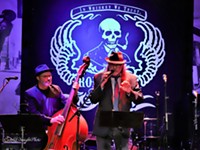
End of an error
Oct 30, 2023 -

Whiskey, surf music — and a bit of Hoochenanny
Oct 16, 2023 -

Season of death
Oct 13, 2023 - More »

